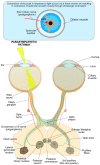Eyeing up the Future of the Pupillary Light Reflex in Neurodiagnostics
- PMID: 29534018
- PMCID: PMC5872002
- DOI: 10.3390/diagnostics8010019
Eyeing up the Future of the Pupillary Light Reflex in Neurodiagnostics
Abstract
The pupillary light reflex (PLR) describes the constriction and subsequent dilation of the pupil in response to light as a result of the antagonistic actions of the iris sphincter and dilator muscles. Since these muscles are innervated by the parasympathetic and sympathetic nervous systems, respectively, different parameters of the PLR can be used as indicators for either sympathetic or parasympathetic modulation. Thus, the PLR provides an important metric of autonomic nervous system function that has been exploited for a wide range of clinical applications. Measurement of the PLR using dynamic pupillometry is now an established quantitative, non-invasive tool in assessment of traumatic head injuries. This review examines the more recent application of dynamic pupillometry as a diagnostic tool for a wide range of clinical conditions, varying from neurodegenerative disease to exposure to toxic chemicals, as well as its potential in the non-invasive diagnosis of infectious disease.
Keywords: acetylcholine; autism; chemicals; cholinergic system; infection; neurodegeneration; pupillometry; recreational drugs; toxins; trauma.
Conflict of interest statement
The authors declare no conflict of interest.
Figures




References
-
- Hirata Y., Yamaji K., Sakai H., Usui S. Function of the pupil in vision and information capacity of retinal image. Syst. Comput. Jpn. 2003;34:48–57. doi: 10.1002/scj.10344. - DOI
-
- Loewenfeld I.E. The Pupil: Anatomy, Physiology, and Clinical Applications. 2nd ed. Butterworth-Heinemann; Boston, MA, USA: 1999.
-
- Winn B., Whitaker D., Elliott D.B., Phillips N.J. Factors affecting light-adapted pupil size in normal human subjects. Investig. Ophthalmol. Vis. Sci. 1994;35:1132–1137. - PubMed
Publication types
LinkOut - more resources
Full Text Sources
Other Literature Sources
Medical

